After the sacking of the Argentinian coach Jorge Sampaoli, the historical Brazilian side CR Flamengo hired their fourth 2023 manager, Adenor Bachi, most known as Tite.
The 62-year-old Brazilian led Brazil’s national team for seven straight years, and although he failed to conduct them to the long-awaited sixth World Cup: the Hexa, he was able to win the 2019 Copa América with players like Neymar Jr (ex-Barcelona and PSG) and Roberto Firmino (ex-Liverpool).
Flamengo, before Tite, were in fifth in the 2023 Brasileirão with 12 wins, eight draws and six defeats, yet with two games left in the calendar, the “Mengão” have 63 points and are only three points apart from the current leader Palmeiras.
This Brazilian league has been quite a rollercoaster, and everything is still up for the four teams at the top.In the #95 October magazine, we described the disharmony between the three different sectors while defending as some of Flamengo’s offensive vulnerabilities.
In this tactical analysis, we’ll try to understand what are Tite’s biggest changes in Flamengo’s defensive tactics and also some adjustments while attacking.
Tite Offensive approach
As we see it, there is a before and after Tite’s Flamengo, and when we refer to their offensive record, everything becomes even more evident.
In his ten games in charge, Flamengo scored sixteen goals, averaging 1.6 goals per game and accounting for almost 30% of their season’s total.
Identical to Sampaoli, Tite likes to build from the back.
Yet, we observe more objective, clearer, and less risky processes under the Brazilian system, where the direct game is a valid option.
They normally attack in a 4-2-1-3, yet as we are going to see further, they like to form a three-man line with the left-back while building up.
The two pivots play an indispensable function in their first phase of construction, where they try to have numeric superiority in such an important zone of the pitch.

These positions are normally occupied by Thiago Maia and Gerson, two very interesting players who not only have the capacity to make a difference in lower zones but also have offensive expertise.
In addition to this obvious function, these two pivots can also function as marking magnets where their defensive correspondents are drawn, leaving a big gap on their backs to be explored.
In order to make this strategy to work, the attackers need to make use of the halfway line and remain deep on the field.
Moreover, as we said, these players can also upset the opposition by venturing through more advanced zones of the pitch.

In fact, most of the teams in the Brasileirão press in a medium block and follow a man-to-man marking, and these two players are constantly being monitored.
With that said they usually demark themselves and surprise the opposition with between-the-lines positioning, as it’s visible above.
The “Mengão” follows an asymmetrical first phase where the left-back, Ayrton Lucas, joins the two centre-backs and integrates the three-man backline.

After leading some of the most talented players on earth for seven years, Tite learned to draw out their best qualities and achieve collective success.
This is precisely the case; players’ qualities were being unexploited, leading them to the unsuccess.
Following the example above, Lucas joined the three-man line not only due to his tactical qualities while building-up but also because of Everton Cebolinha’s abilities to create danger by the wing.
As a matter of fact, in the course of our analysis, we realised that one of the strictest policies in Tite’s game plan has to do with the space occupation on the corridors.
In other words, the winger or midfielder should be inside when the full-back is open right on the touchline.

This tactic is transversal for both wings, and 20-year-old Wesley França is seen exploring the full width of the pitch on the right while the winger is in more interior terrains.
It’s also important to note that the depth these players give depends on which phase of the offensive process they are into and the opposition’s pressing intensity.
It’s evident that if a team’s block is high, the full-back will descend and support the ball carrier.
Moreover, in the first phase of construction, the left-back remains open, whereas is the goalkeeper the one who performs as a middle element in the backline.
Indeed, under Tite, Agustín Rossi has been the most common goalkeeper not only due to his qualities between the posts but also due to his on-the-ball technical quality, which makes him an important asset in Flamengo’s offensive process.
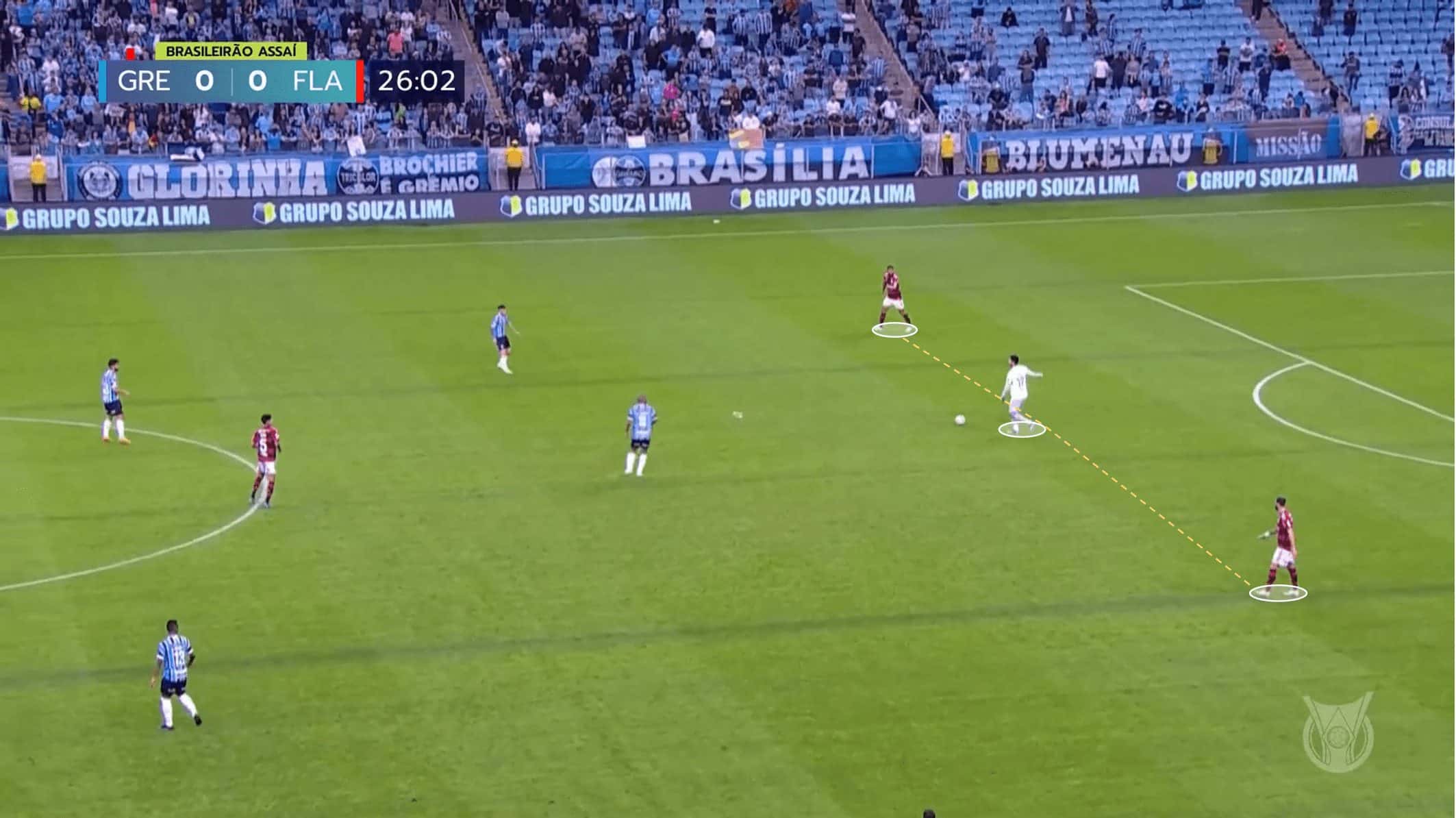
Giorgian De Arrascaeta is another player integrant of Jorge Jesus’ super team and has been outstanding for the “Mengão” in these last few years, especially through his goal contributions.
He feels comfortable exploring the space between the lines and then giving continuation to the play through his technical and tactical skills.
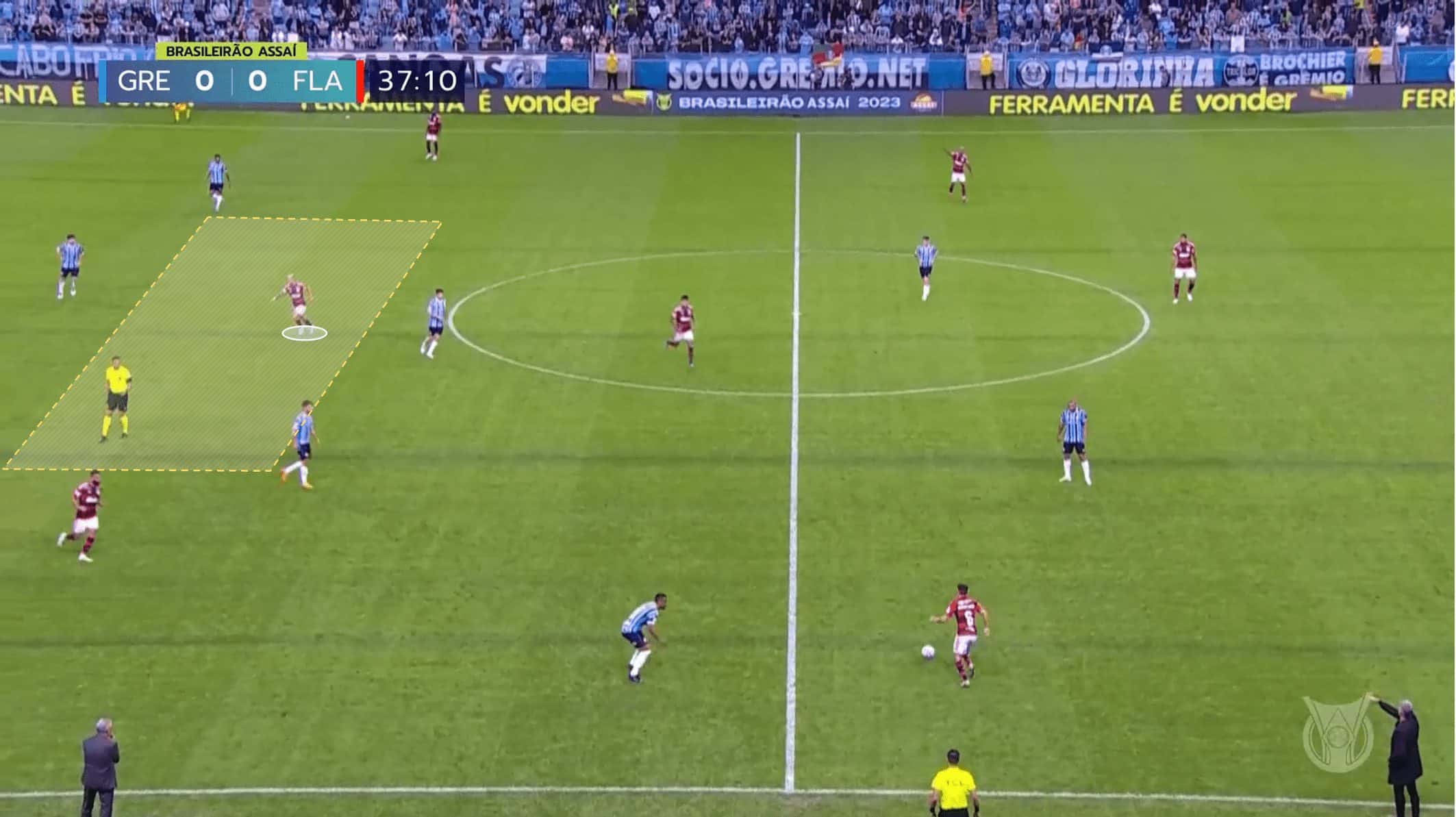
As we mentioned, such a space is created by having the attackers high and the two pivots lower, and Arrascaeta takes advantage of that by being a linking element, not only in organisation but also in transition.
Similar to what happened in the 2022 World Cup under Tite’s leadership, Pedro was chosen over Gabriel Barbosa to play as a solo striker.
Since then, he has scored seven goals, contributing to nearly 44% of Flamengo’s total goals.
He is a player with a strong aerial and endowed with a relatively good technique, which allows him to be a solution for a direct or passing play.
A very typical play is when the Brazilian striker descends or waits between the lines for the pass.
Generally, a big gap is created in the defensive line’s back when this happens since the intervinients were attracted to such a movement.
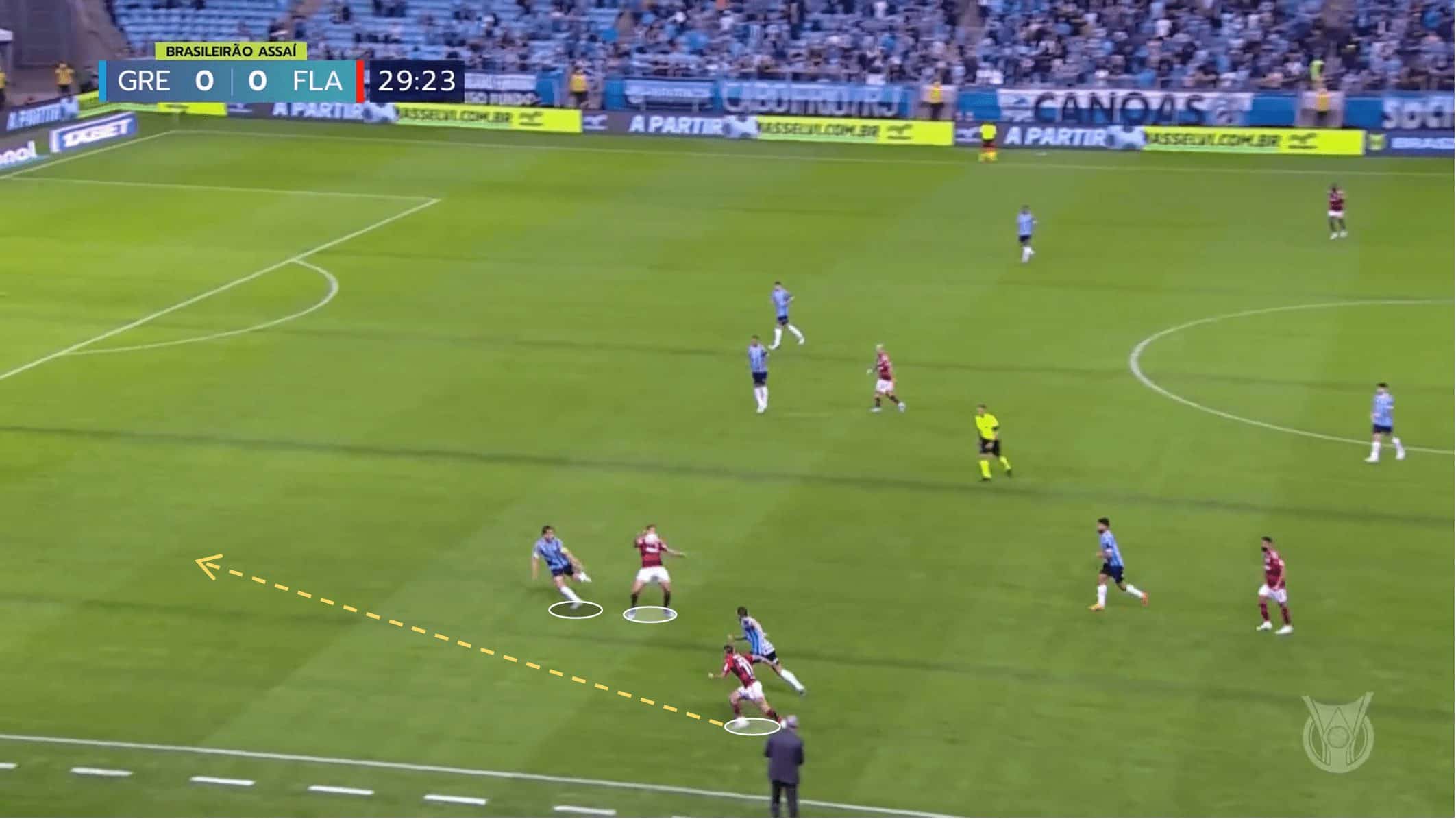
The wingers automatically attack such a gap and take advantage of their speed and technique to upset their opponents.
This movement normally is made by an outside-to-inside positioning, right in between the space of the full-back and centre-back, even if Pedro is not involved in the play.
Tite Defensively
Apart from their offensive record, Flamengo also improved their defensive history by conceding nine goals in the last 10 games, an average of 0,9 per match.
Although it’s not a perfect register, we noticed significant changes vital for increasing their defensive cohesion, one of our biggest critics of Sampaoli’s model.
Their defensive approach is based on a 4-4-2 medium-low defensive block, yet like most teams, it’s a dynamic model where some changes can be made according to the opponent they are facing.

When a team starts playing with three elements, generally, they add one of the wingers to the first pressing line, forming a 4-3-3 game plan.
In addition, they have also shown tactical awareness of when to shorten the distance between the different defensive blocks.
Such cohesion is strengthened through the willingness and commitment by the attacking elements on the defensive approach.
As we mentioned in the magazine, in Flamengo some players neglected their defensive obligations due to their crucial offensive contributions.
Under Tite, there’s no debate on that and all the players should meet their defensive endeavours.
We would like to address this matter with the wingers, who, in our opinion, are the attackers who can influence their team on a defensive basis.
In modern football, playing with deep full-backs has become a trend, and the teams need to adapt their defensive system to it.
One of the alternatives is to make the winger lower his positioning and keep up with the defender, where in most cases, a five-man line is formed.
The Brazilian head coach seemed to interiorise this idea inside Flamengo’s attacking elements, and below, we can see Cebolinha defending right next to the left-back.
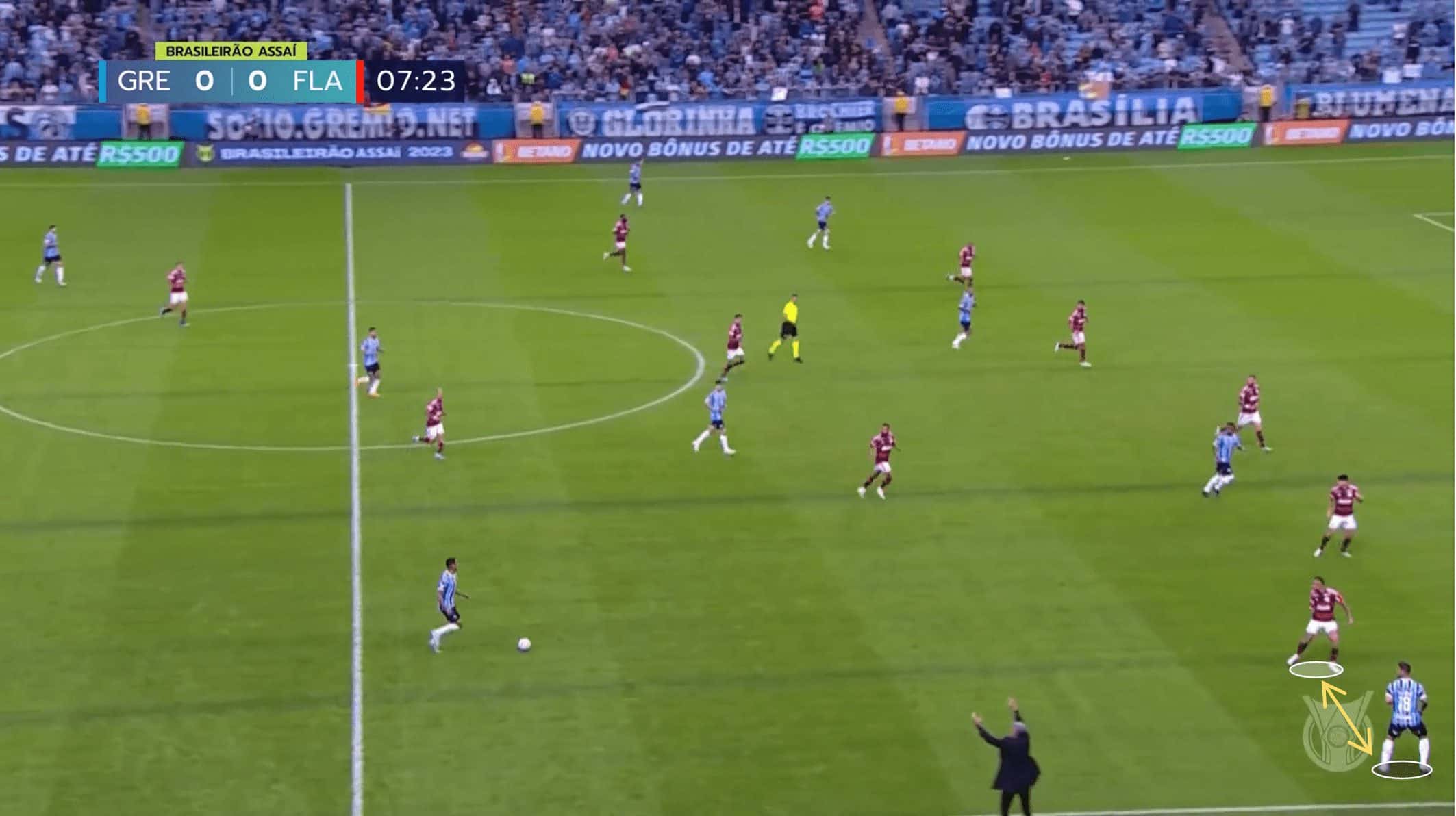
Apart from that, man-to-man marking is commonly used during their pressing, perhaps because of its efficiency in obstructing the opposition’s offensive process.
This allowed them to win several duels but also created big gaps for the opposition to play.
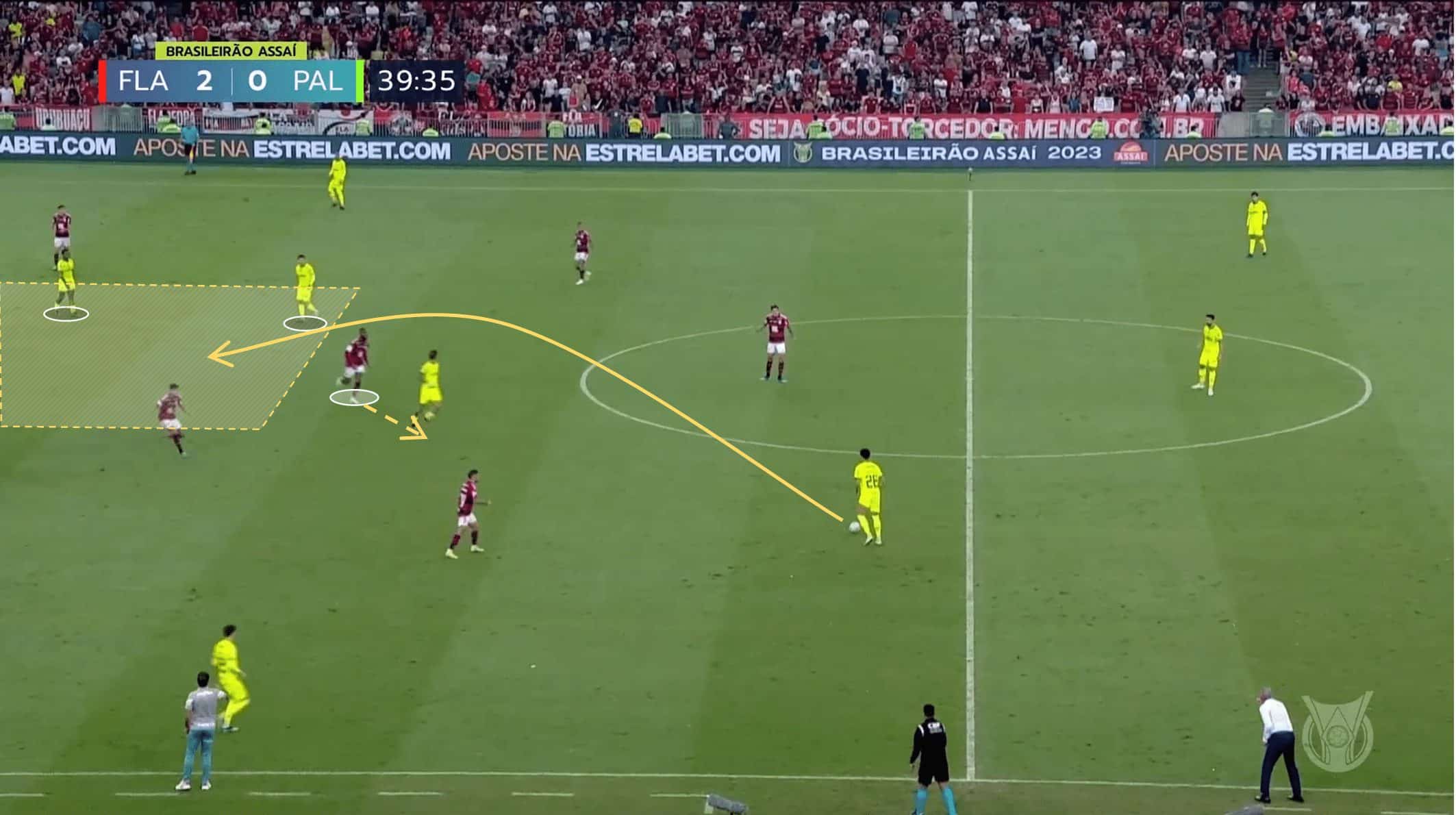
In these situations, it’s essential to have the all team coordinated while increasing their defensive block to successfully block the ball carrier while the target is being marked.
If the player whose pass is going to be made to is pressed but the ball carrier is in an uncovered ball situation, then a pass into the back of the midfielder can be made.
Finally, we would also like to address that since Tite took charge, his team has been way more balanced and less exposed while attacking, preventing them from counterattack situations.
Yet, Brasileirão is a league characterised by transitions, and as it goes, Flamengo falls into this kind of game at some point.
Conclusion
Although more recently, they were disappointed, beaten 3-0 against Atlético Mineiro, it’s inevitable to say that Tite is doing a great job with a team whose league hopes resurged from nothing.
In this scout report, we first approached some of the reasons for their success and offensive consistency in the last ten games.
In our opinion, these had to do in great part with the Tite’s ability to take the best from each player in a specific position on the field, whereas the left-back acts as centre-back while building up and the right-back as a winger.
Apart from that, some details, like the pivots’ unpredictability and good combinations between Pedro and the wingers, were also important for their offensive success.
We attribute “Mengão’s” defensive improvements to a mental shift in the attackers’ willingness to follow the rest of the team in a defensive situation.
To be more precise, we believe that wingers can have a significant impact in off-the-ball situations.
Since Tite took charge, this issue has been resolved.
Finally, we also referred to the man-to-man marking as a mostly positive aspect in a team’s game, yet in order to be successful some requirements should be filled.






Comments